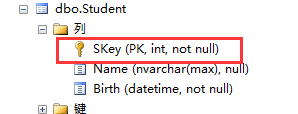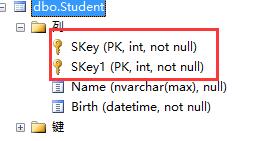code first :约定大于配置(通过配置实体重写约定)
通过两种方式配置实体:DataAnnotations Fluent Api
System.ComponentModel.DataAnnotations命名空间中只定义了部分实体验证的特性,在EntityFramework程序集中定义了更多的数据映射特性
DataAnnotations是基于实体配置的一些简单的特性,所在命名空间:System.ComponentModel.DataAnnotations
- KeyAttribute:对数据库中表的主键的设置
- RequiredAttribute:对应数据库中字段的数据是否可以为null
- MaxLengthAttribute:对应数据库中字符串类型字段的最大长度
- MinLengthAttribute:在数据库中无对应,但在代码中字符串最小长度
- ConcurrencyCheckAttribute:指定用于开放式并发检查的列的数据类型,用于任何数量任何类型的属性中
- TimestampAttribute:将列的数据类型指定为行版本,只能用于单字节类型的属性中
- DatabaseGeneratedAttribute:标记指定实体属性是由数据库生成的,并指定生成策略(None数据库不生成值,Identity当插入行时,数据库生成值,Computed当插入或更新行时,数据库生成值),此属性是只读的。可用来映射成自动增长列
- ColumnAttribute:指定实体属性在数据库中的列名及数据类型
- TableAttribute:指定实体类对应的数据表名
- ForeignKeyAttribute:指定导航属性的外键字段
- NotMappedAttribute:标记指定实体属性在创建数据库中不创建对应字段
- ComplexTypeAttribute:标记指定实体属性是将一个对象作为另一个对象的属性,映射到数据库中则子对象表现多个属性字段
- StringLengthAttribute:在数据字段中指定最大和最小的字符长度
- IndexAttribute:创建索引
- InversePropertyAttribute:用在类之间有多重关系的时候
对于实体关系对应的数据表关系,无非“0:1,1:1,0:N,1:N,N:N”这几种,可以使用导航属性中的数据类型来表示,0…1端使用单个实体类型表 示,N端使ICollection<T>集合类型表示.对于单实体端,默认是可为空的,即为0关系,如果要设置为1关系,要使用 [Required]标签来进行标记。但对于一对一中的关系主体与依赖对象确无法做更细节的控制.DataAnnotations可以同时在同一个类后者属性上使用多个标记属性.
例子:
1 [Table("Student")]//生成数据库对应的Student表 2 public class StudentInfo 3 { 4 [Key]//即使属性不是以Id或者类名+id命名的 也会把SKey创建为主键 ,单个主键为自动增长 5 public int SKey { get; set; } 6 public string Name { get; set; } 7 public char Gender { get; set; } 8 public DateTime Birth { get; set; } 9 10 //public ClassInfo ClassInfo { get; set; } 11 12 //public Teacher Teacher { get; set; } 13 }

复合主键:指定主键列的顺序[Column(Order=1)],复合主键不自增
1 [Table("Student")]//生成数据库对应的Student表 2 public class StudentInfo 3 { 4 [Key] 5 [Column(Order =1)] 6 public int SKey { get; set; } 7 [Key] 8 [Column(Order =2)] 9 public int SKey1 { get; set; } 10 public string Name { get; set; } 11 public char Gender { get; set; } 12 public DateTime Birth { get; set; } 13 14 //public ClassInfo ClassInfo { get; set; } 15 16 //public Teacher Teacher { get; set; } 17 }

同样还使用到Table和Column特性的用法。

1 [Table("Student",Schema ="ray")]//生成数据库对应的Student表 2 public class StudentInfo 3 { 4 [Key] 5 [Column(Order =1)] 6 public int SKey { get; set; } 7 //[Key] 8 //[Column(Order =2)] 9 //public int SKey1 { get; set; } 10 //[Required] 11 //[MaxLength(40),MinLength(4)] 12 public string Name { get; set; } 13 [Column("性别",TypeName ="Nvarchar()")] 14 public char Gender { get; set; } 15 [Required(AllowEmptyStrings =true),StringLength(100)] 16 public string Mark { get; set; } 17 [NotMapped] 18 public int Age { get; set; } 19 public DateTime Birth { get; set; } 20 [Timestamp] 21 public byte[] RowVersion { get; set; } 22 //只读和只写属性不会创建数据库列 23 public int Nokey1 { get { return 1; } } 24 public int Nokey2 { set { value = 2; } } 25 public int CID { get; set; } 26 [ForeignKey("CID")] 27 public ClassInfo ClassInfo { get; set; } 28 29 //public Teacher Teacher { get; set; } 30 }

1 public class ClassInfo 2 { 3 [Key] 4 public int ID { get; set; } 5 public string Name { get; set; } 6 //每班都有很多学生 7 public ICollection<StudentInfo> Students { get; set; } 8 //public ICollection<Teacher> Teachers { get; set; } 9 }
